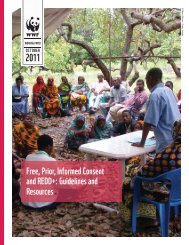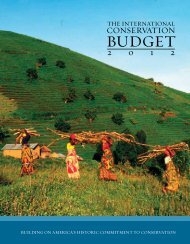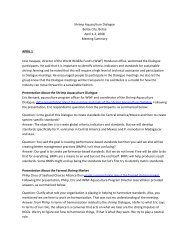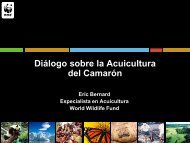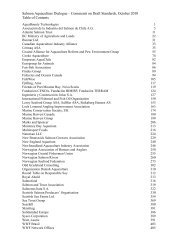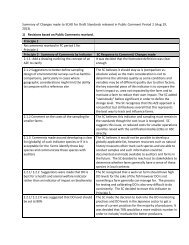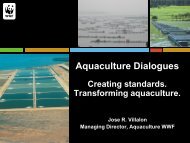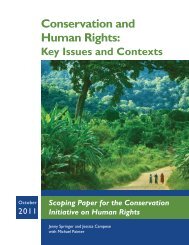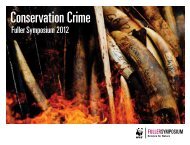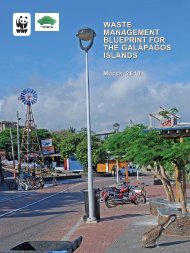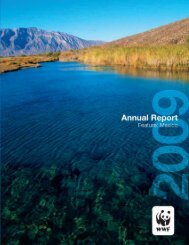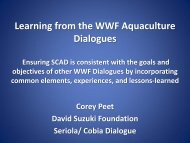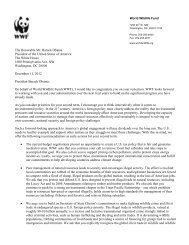Amazon - World Wildlife Fund
Amazon - World Wildlife Fund
Amazon - World Wildlife Fund
Create successful ePaper yourself
Turn your PDF publications into a flip-book with our unique Google optimized e-Paper software.
All PhOTOs © wwf-us<br />
Jason Clay<br />
Vice President<br />
Market Transformation<br />
WWF<br />
Tom Lovejoy<br />
Professor, George Mason<br />
University; Biodiversity<br />
Chair, the Heinz Center;<br />
Member of the Board, WWF<br />
Meg Symington<br />
Managing Director<br />
<strong>Amazon</strong> Program<br />
WWF<br />
Poison dart frogs<br />
<strong>Amazon</strong> river dolphin<br />
© TODD PussER / npl / MinDEn PictuREs © MichAEl D. Kern<br />
Making conservation history<br />
by safeguarding the world’s<br />
richest ecosystem<br />
MEG SYMINGTON One of the things that’s most outstanding<br />
about the <strong>Amazon</strong>, in my mind, is its biodiversity.<br />
We say that 10 percent of all known species<br />
on Earth are found here, but really, it could be up<br />
to 33 percent if you include those species still being<br />
identified.<br />
TOM One of the other interesting aspects of biodiversity<br />
is how it contributes to the development of the<br />
life sciences and spills over and has health benefits.<br />
Literally, there are tens if not hundreds of millions of<br />
people who take ACE inhibitors for their high blood<br />
pressure, and that all goes back to how the venom<br />
of the bushmaster works. The bushmaster is a big,<br />
nasty snake that lives in the <strong>Amazon</strong>, and basically<br />
it makes its prey’s blood pressure go to zero. Forever.<br />
By studying the venom, researchers uncovered the<br />
system of regulation called the angiotensin system.<br />
That’s what the ACE inhibitors were designed to<br />
work on. Until somebody was looking at how the<br />
venom worked, nobody had a clue how to do this.<br />
The world’s largest<br />
tropical rain forest,<br />
the <strong>Amazon</strong> encompasses<br />
a staggering<br />
1.4 billion acres.<br />
TOM LOVEJOY People don’t realize how important<br />
MEG And the toxins in the poison dart frogs are also<br />
biodiversity is, in terms of how many fundamen-<br />
being used to develop heart stimulants.<br />
tal resources it provides, how it supports all living<br />
things – including people.<br />
JASON I don’t think what is economically valuable<br />
from the <strong>Amazon</strong> has even really been tapped yet.<br />
MEG True. We rely on biodiversity to help us discover<br />
new medicines and to learn how to grow food<br />
TOM When you get to the <strong>Amazon</strong>, you really un-<br />
Ringed kingfisher<br />
© R.IsOTTi, A.cAMBOne - Homo AMBiens / WWF-cAnon<br />
more productively. We’re not just preserving the<br />
<strong>Amazon</strong> for preservation’s sake.<br />
JASON CLAY For example, there is a palm tree there,<br />
called peach palm, that’s so productive it actually<br />
makes ten times more vegetable protein and calories<br />
per acre than the best corn in Iowa. So as we strive to<br />
feed 9 billion people on this planet, with most of them<br />
living in the tropics, we’re going to start looking to<br />
plants like the peach palm to solve the food shortage.<br />
derstand that this is a living planet. It’s a physical<br />
and biological system linked together, and forests<br />
as a whole play a huge role in all of that, especially<br />
when it comes to climate. It’s pretty simple to the extent<br />
that if you destroy the forest, the carbon that<br />
was stored in the trees goes up in the atmosphere and<br />
creates more climate change. And if you reforest, you<br />
can pull some of that carbon out of the atmosphere,<br />
you can start managing the planet in a much more<br />
sensible way than we’ve been doing.<br />
The <strong>Amazon</strong> River<br />
is so massive it<br />
actually contains<br />
more water than the<br />
Mississippi, the Nile<br />
and the Yangtze<br />
rivers combined.<br />
4 worlDWildliFE.ORG/pulse<br />
Pulse: The hEART of consERvATion<br />
5



